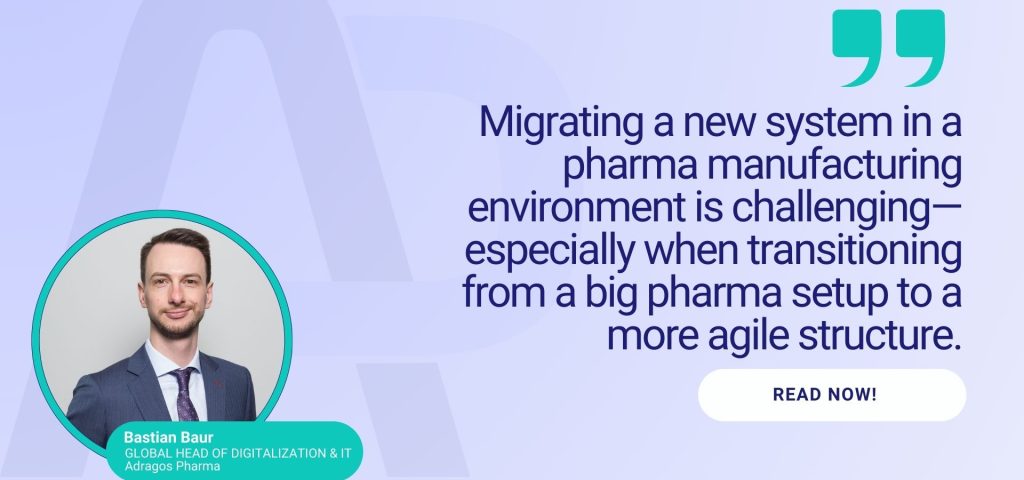I love swimming. I love the fresh water and the steadiness of swimming line after line – clearing my mind. I also enjoy pushing myself to improve my SWOLF (a measure of swimming efficiency) while refining my technique. The discipline, focus, and determination required to reach personal best in swimming closely mirror the mindset needed for successful digital transformation projects.
There are many parallels between swimming personal bests and some of the major digitalization projects I’ve been working on as Adragos Pharma’s Global Head of Digitalization & IT.
Both require:
- Confidence in past experiences to replicate and improve performance
- Familiarity with the route and a clear strategy
- Discipline and structured preparation
- Hard work and continuous refinement
- Steady focus on objectives
- Determination to push through challenges
- A thorough warm-up and preparation phase
- Effective communication with the team to stay aligned and avoid roadblocks
Personal Best in Bussiness
Leading large-scale digital projects requires a combination of experience, structure, and adaptability. At Adragos Pharma, our digitalization efforts are not just about implementing new systems but about transforming the way we operate, ensuring efficiency, and positioning our company for future success.
We recently completed a 12-month Enterprise Resource Planning (ERP) implementation at our manufacturing site in Kawagoe, Japan. SAP projects of this scale are complex. With over 200 end-users, 35 consultants at peak times, and 25 key users, subject matter experts, and process owners involved, the stakes were high.
Our transition from R3 to S/4HANA was completed on time and within budget—a significant achievement in the SAP landscape. One of the key factors in our success was a strong governance model, with a dedicated steering committee and project managers overseeing both the business and IT aspects. My role involved liaising across multiple teams, ensuring alignment, addressing issues, and keeping the project on track.
Migrating and implementing a new system in a large manufacturing environment is challenging—especially when transitioning from a big pharma setup to a more agile, independent structure. Everything from user requirements to interfaces and standardized process templates had to be meticulously planned. Core business processes like procurement-to-pay and store-to-ship needed to be mapped out clearly before development and implementation.
The structured approach followed industry best practices: workshops to define requirements, a development and implementation phase spanning several months, and rigorous training, testing, and validation. In the pharmaceutical industry, ensuring that IT systems comply with strict quality standards is non-negotiable, making validation a critical component.
Ultimately, the project’s success was driven by a combination of technical excellence and organizational change management. Without the effort of everyone in our internal and external team in the project, we couldn’t have done it. The willingness and openness to change and seeing the overall benefits of the new system was key to a successful launch.
Moving from imprementations to operations
With the system successfully launched, the next phase focused on transitioning from project mode to long-term operational stability. A key aspect of this was establishing an application-managed services framework with a new external partner. This ensures ongoing support, continuous improvement, and adherence to governance and process standards.
Beyond managing this transition, my role involves supporting the team with day-to-day operations, addressing issues, and refining configurations as needed. Ensuring that the system runs smoothly and remains aligned with business objectives is a long-term commitment.
Doing it again – but faster
With Japan’s ERP implementation successfully completed, we are now leveraging that experience for our next rollout in Norway. This time, we are reducing the timeline from 12 months to nine by capitalizing on the foundation we built in Japan. Working in close collaboration with our partner company, Halden Pharma, we are applying lessons learned, reusing established processes, and streamlining implementation.
The ability to take what we’ve learned and optimize for future projects is a key part of driving digital transformation. Our major SAP project demonstrated that we can execute efficiently, adapt quickly, and deliver results. Now, we are building on that momentum to enhance efficiency, coordination, and cooperation across our global operations.
Digital transformation is an ongoing journey, not a one-time event. In our project in Japan, we demonstrated our ability to learn quickly, adapt efficiently, and deliver impactful results. Now, we are taking these experiences and applying them across our organization to foster greater efficiency, coordination, and collaboration.
Each successful implementation strengthens our capabilities, enhances operational resilience, and prepares us for the next challenge.

